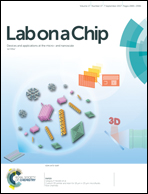Label-free, high-throughput holographic screening and enumeration of tumor cells in blood†
Abstract
We introduce inline digital holographic microscopy (in-line DHM) as a label-free technique for detecting tumor cells in blood. The optimized DHM platform fingerprints every cell flowing through a microchannel at 10 000 cells per second, based on three features – size, maximum intensity and mean intensity. To identify tumor cells in a background of blood cells, we developed robust gating criteria using machine-learning approaches. We established classifiers from the features extracted from 100 000-cell training sets consisting of red blood cells, peripheral blood mononuclear cells and tumor cell lines. The optimized classifier was then applied to targeted features of a single cell in a mixed cell population to make quantitative cell-type predictions. We tested our classification system with tumor cells spiked at different levels into a background of lysed blood that contained predominantly peripheral blood mononuclear cells. Results show that our holographic screening method can readily detect as few as 10 tumor cells per mL, and can identify tumor cells at a false positive rate of at most 0.001%. This purely optical approach obviates the need for antibody labeling and allows large volumes of sample to be quickly processed. Moreover, our in-line DHM approach can be combined with existing circulation tumor cell enrichment strategies, making it a promising tool for label-free analysis of liquid-biopsy samples.



 Please wait while we load your content...
Please wait while we load your content...